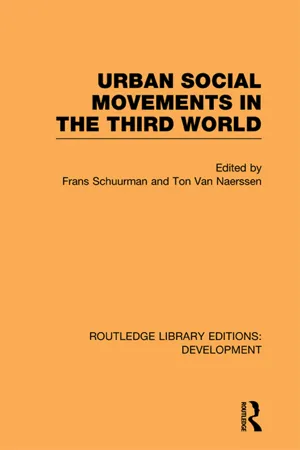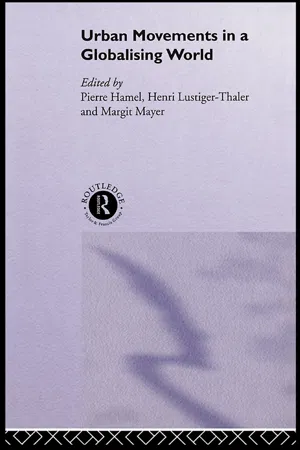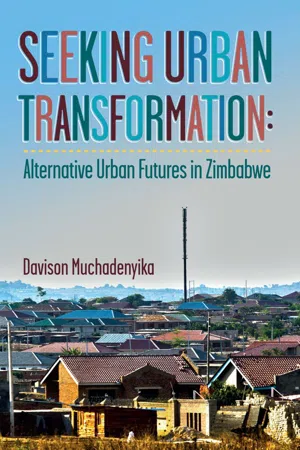History
Urban Reform Movement
The Urban Reform Movement refers to a period of social and political activism aimed at addressing the challenges of urbanization in the late 19th and early 20th centuries. It sought to improve living and working conditions in cities, advocating for reforms such as better sanitation, housing regulations, and labor laws. The movement was a response to the rapid growth of cities and the resulting social problems.
Written by Perlego with AI-assistance
Related key terms
1 of 5
4 Key excerpts on "Urban Reform Movement"
- eBook - PDF
Local Protests, Global Movements
Capital, Community, and State in San Francisco
- Karl Beitel(Author)
- 2012(Publication Date)
- Temple University Press(Publisher)
Placed in a broader historical context, urban movements may be seen as part of a larger shift in the nature of many contemporary anti-systemic movements that emerged out of the turmoil of the 1960s. The historical context out of which these movements emerged was opposition to the top-down, hierarchical, and antidemocratic nature of urban renewal. Urban movements have sought to construct a new type of re-lationship between local residents and local government (on these themes in relation to urban social movements, see Hirsch 1991 and Mayer 1994, 2006, 2010). Calls for restructuring local government to allow for greater popular participation point toward a democratic transformation of the state. I argue that this is the potentially prefigurative element of the types of struggles we observe in San Francisco, as it implies a rethinking of the traditional bound-aries that delineate state and society, and the reconstitution of the very nature of urban government through the (partial) dissolution of the state into the self-regulating organs of civil society. 58 Chapter 3 At the same time, the fragmented, often highly site-specific nature of strug-gles organized on a neighborhood or issue-specific basis explains the highly particularistic reasoning by which groups exercise claims to political entitle-ments. This characteristic has given rise to a political culture predicated on reciprocal deferral among community-based organizations to different groups’ claims to act as the legitimate representatives of a particular set of low-income community constituents. - eBook - ePub
- Frans Schuurman, Ton Van Naerssen(Authors)
- 2012(Publication Date)
- Routledge(Publisher)
In general it has apparently taken radical social scientists some time to get used to the above mentioned situation and to look for groups other than the labor proletariat which, at least potentially, could be carrying the red lantern of social change. This quest has resulted in (re)discovering the new social movements, whereby the urban social movements in developed and underdeveloped countries alike are considered to be of prime interest.DEFINITIONS OF SOCIAL MO VEMENTS
The international discussion on how to define urban social movements is increasingly characterized by a strong tendency towards academic involution, invoking reminiscences of the debate in the early 1970s on the nature of the informal sector. Sighs of relief then could be detected when Bromley and Gerry (1979) finally and rather pragmatically suggested not wasting any more energy on definitions of the informal sector and henceforth to focus on the “casual urban poor”, whether informal or not.Every author writing about urban social movements presents his own definition of the phenomenon. Reviewing a series of definitions it soon becomes clear that a criterion like “attaining societal transformation” is useful to bring about some order. If we use that criterion to construct a continuum, then we have on the one extreme those definitions which do not refer to external effects like societal transformation. These are dictionary type definitions of an urban social movement, e.g. “every collective effort in an urban context to solve a problem”.Moving along the continuum the definitions reflect an increasing leftist/radical political philosophy, whereby at the same time the potential number of urban social movements answering to the description is decreasing. This results in defining an urban social movement as a “collective action leading to societal transformation”. Some examples of definitions of an urban social movement strung along the continuum are the following:A specific form of collective action with a specific rationality, specific resources anda collective identity. (Roth, 1987) - eBook - ePub
- Pierre Hamel, Henri Lustiger-Thaler, Margit Mayer(Authors)
- 2003(Publication Date)
- Taylor & Francis(Publisher)
IntroductionUrban social movements—local thematics, global spaces
Pierre Hamel, Henri Lustiger-Thaler and Margit Mayer
The study of urban social movements and the specificity of their collective actions have traditionally occupied a limited and marginal status in social movement theories and deliberations. This is due to a long-standing perception of urban movements in collective action theories both in Europe and the USA, Urban movements have usually been thought of as heavily vested in micro-, as opposed to macro-, social processes, underscoring the local characteristics of a specific urban political economy. This has led to a suspicion in the wider social sciences that urban movements are too readily interwoven in mediational processes or, worse, the humdrum of municipal politics, with its input/output policy factors. From a disciplinary standpoint, being so uniquely identified with the very essence of locality, as a form of collective action, has meant a strong association with community research studies, local growth and anti-growth machine coalitions, the stuff of the traditional as well as the new urban sociology and political science.From this viewpoint, urban movements have not been traditionally perceived as representative of broader values, ideals or emancipatory possibilities, that have been standardly attributed to identity-based movements concerned with a claim on totality, such as the women’s, environmental, civil rights, peace and human rights movements. Yet, even in the face of this implicit/explicit framing of action, urban movements are more and more recognised as very modern indeed in terms of how they articulate locality and what lies beyond. We might say that urban movements harbour a pervasive transfunctionality in terms of their corresponding state structures. They are not fearful of institutionalisation. In many cases they seek it out. They are corporatist and increasingly find expression in partnerships of all stripes and countenances, if the strategic environment is so predisposed. The latter, however, do not account for all their functions. They have another embedded characteristic: they are key to the social construction of conflict within the city. And this is often the case concerning processes within which urban movements are committed players. Their transfunctionality brings together service roles-and conflict roles, as they pre-score the scripts and narratives of local politics. - eBook - PDF
Seeking Urban Transformation
Alternative Urban Futures in Zimbabwe
- Davison Muchadenyika(Author)
- 2020(Publication Date)
- Weaver Press(Publisher)
Seeking Urban Transformation: Alternative Urban Futures in Zimbabwe 196 9 Redefining a New Urban Future Cities are the present and the future. The transformation of African cities as the Zimbabwean experience shows, will depend on the actions and inactions of ordinary people. My aim has been to elucidate the interaction between planning institutions and social movements in the delivery of low-income housing, which is characterized by contestations, struggles and alliances that continue to profoundly shape urban development and housing in metropolitan Harare. As argued, such struggles have been both internal (within movements) and external (between movements and planning authorities). In the post-2000 era, three distinct features of transformation characterize Metropolitan Harare: (i) changes in urban fabric, (ii) reconfiguration of power and (iii) policy changes. The features relate to the provision of new housing and infrastructure services to the predominantly urban poor population; they play a vital role in urban development and the adoption by planning institutions of grassroots-centered, urban-planning approaches. The dynamics of such transformation differs contextually and are influenced by the nature and conduct of social movements and the responses of planning authorities. Urban transformation in Zimbabwe has been facilitated through ongoing struggles and continued pressure from social movements in pursuit of social and spatial justice. Through strategies such as demonstration of alternatives, negotiation, confrontation, and defiance, housing movements have compelled local authorities and the government to concede to new forms of planning, for example, by regularization and formalization of housing developed by social movements. Fundamental features of radical planning are evident in the way community organizations and social movements are changing existing
Index pages curate the most relevant extracts from our library of academic textbooks. They’ve been created using an in-house natural language model (NLM), each adding context and meaning to key research topics.



